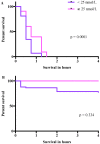Vitamin D Depletion in Pregnancy Decreases Survival Time, Oxygen Saturation, Lung Weight and Body Weight in Preterm Rat Offspring
- PMID: 27571350
- PMCID: PMC5003352
- DOI: 10.1371/journal.pone.0155203
Vitamin D Depletion in Pregnancy Decreases Survival Time, Oxygen Saturation, Lung Weight and Body Weight in Preterm Rat Offspring
Abstract
Animal studies suggest a role of vitamin D in fetal lung development although not studied in preterm animals. We tested the hypothesis that vitamin D depletion aggravates respiratory insufficiency in preterm rat offspring. Furthermore, the effects of vitamin D depletion on growth and lung surfactant were investigated. Female Sprague-Dawley rats were randomly assigned low vitamin D (VDL) or control diet before mating and followed with serum 25-hydroxyvitamin D (s-25(OH)D) determinations. After cesarean section at gestational day 19 (E19) or day 22 (E22), placental weight, birth weight, crown-rump-length (CRL), oxygenation (SaO2) at 30 min and survival time were recorded. The pup lungs were analyzed for phospholipid levels, surfactant protein A-D mRNA and the expression of the vitamin D receptor (VDR). S-25(OH)D was significantly lower in the VDL group at cesarean section (12 vs. 30nmol/L, p<0.0001). Compared to the controls, E19 VDL pups had lower birth weight (2.13 vs. 2.29g, p<0.001), lung weight (0.09 vs. 0.10g, p = 0.002), SaO2 (54% vs. 69%, p = 0.002) as well as reduced survival time (0.50 vs. 1.25h, p<0.0001). At E22, the VDL-induced pulmonary differences were leveled out, but VDL pups had lower CRL (4.0 vs. 4.5cm, p<0.0001). The phospholipid levels and the surfactant protein mRNA expression did not differ between the dietary groups. In conclusion, Vitamin D depletion led to lower oxygenation and reduced survival time in the preterm offspring, associated with reduced lung weight and birth weight. Further studies of vitamin D depletion in respiratory insufficiency in preterm neonates are warranted.
Conflict of interest statement
The authors confirm that the financial support by Takeda Pharma does not alter the authors' adherence to PLOS ONE policies on sharing data and material.
Figures






Similar articles
-
Reduced Dietary Calcium and Vitamin D Results in Preterm Birth and Altered Placental Morphogenesis in Mice During Pregnancy.Reprod Sci. 2020 Jun;27(6):1330-1339. doi: 10.1007/s43032-019-00116-2. Epub 2020 Jan 1. Reprod Sci. 2020. PMID: 32046423
-
Maternal early pregnancy vitamin D status in relation to low birth weight and small-for-gestational-age offspring.J Steroid Biochem Mol Biol. 2018 Jan;175:146-150. doi: 10.1016/j.jsbmb.2017.09.010. Epub 2017 Sep 20. J Steroid Biochem Mol Biol. 2018. PMID: 28939424
-
Vitamin D depletion does not affect key aspects of the preeclamptic phenotype in a transgenic rodent model for preeclampsia.J Am Soc Hypertens. 2016 Jul;10(7):597-607.e1. doi: 10.1016/j.jash.2016.05.008. Epub 2016 Jun 4. J Am Soc Hypertens. 2016. PMID: 27450577
-
Post-hoc comparison of vitamin D status at three timepoints during pregnancy demonstrates lower risk of preterm birth with higher vitamin D closer to delivery.J Steroid Biochem Mol Biol. 2015 Apr;148:256-60. doi: 10.1016/j.jsbmb.2014.11.013. Epub 2014 Nov 13. J Steroid Biochem Mol Biol. 2015. PMID: 25448734 Free PMC article. Review.
-
Vitamin D and risk of preterm birth: Up-to-date meta-analysis of randomized controlled trials and observational studies.J Obstet Gynaecol Res. 2017 Feb;43(2):247-256. doi: 10.1111/jog.13239. J Obstet Gynaecol Res. 2017. PMID: 28150405 Review.
Cited by
-
Chinese herbal formula Fuzheng Huayu alleviates CCl4-induced liver fibrosis in rats: a transcriptomic and proteomic analysis.Acta Pharmacol Sin. 2018 Jun;39(6):930-941. doi: 10.1038/aps.2017.150. Epub 2017 Nov 2. Acta Pharmacol Sin. 2018. PMID: 29094729 Free PMC article.
-
Vitamin D: What We Know and What We Still Do Not Know About Vitamin D in Preterm Infants-A Literature Review.Children (Basel). 2025 Mar 20;12(3):392. doi: 10.3390/children12030392. Children (Basel). 2025. PMID: 40150674 Free PMC article. Review.
-
[Protective effect of vitamin D against hyperoxia-induced bronchopulmonary dysplasia in newborn mice].Nan Fang Yi Ke Da Xue Xue Bao. 2019 Jul 30;39(7):816-822. doi: 10.12122/j.issn.1673-4254.2019.07.11. Nan Fang Yi Ke Da Xue Xue Bao. 2019. PMID: 31340915 Free PMC article. Chinese.
-
Perinatal Undernutrition, Metabolic Hormones, and Lung Development.Nutrients. 2019 Nov 23;11(12):2870. doi: 10.3390/nu11122870. Nutrients. 2019. PMID: 31771174 Free PMC article. Review.
-
New insights into the vitamin D requirements during pregnancy.Bone Res. 2017 Aug 29;5:17030. doi: 10.1038/boneres.2017.30. eCollection 2017. Bone Res. 2017. PMID: 28868163 Free PMC article. Review.
References
-
- Vannucchi C, Silva L, Lúcio C, Regazzi F, Veiga G, Angrimani D. Prenatal and Neonatal Adaptations with a Focus on the Respiratory System. Reproduction in Domestic Animals. 2012;47:177–81. - PubMed
-
- Hermansen CL, Lorah KN. Respiratory Distress in the Newborn. American Family Physician. 2007;76:987–94. - PubMed
-
- Ballard PL, Ballard RA. Scientific basis and therapeutic regimens for use of antenatal glucocorticoids. Am J Obstet Gynecol. 1995;173(1):254–62. - PubMed
MeSH terms
Substances
LinkOut - more resources
Full Text Sources
Other Literature Sources
Medical

